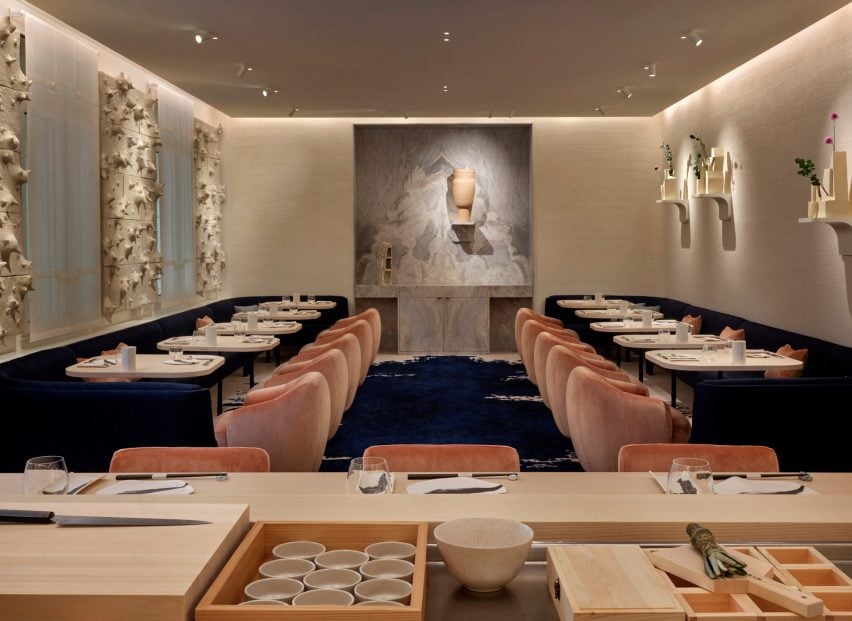Artworks are dotted throughout the interior of restaurant L’Abysse Monte Carlo in Monaco, for which its designers Laurence Bonnel and Rowin Atelier took cues from the Seto Inland Sea archipelago.
Bonnel, who led the design and is the founder of Paris art gallery Scene Ouverte, also drew on the food served at the restaurant when creating the design.
Headed up by chef Yannick Alléno and sushi connoisseur Yasunari Okazak, L’Abysse Monte Carlo mixes French cuisine with Japanese culinary traditions.
“The design has been inspired by the atmosphere Yannick Alléno wanted for the Abysse – precious and warm, a French vision of the way you feel in Japan,” Bonnel told Dezeen.
“The sea, as it is a sushi restaurant, has also inspired the design,” she added.
“Monte Carlo’s unique blend of French Riviera chic and international flair also influenced the design. I also wanted to create a sense of clarity, so upon entering, one feels immediately transported, as if stepping away from the world.”
Bonnel has mixed materials including marble, travertine, wood, ceramics and velvet for the interior of the 90-square-metre restaurant, which is located inside the Hôtel Hermitage in Monte Carlo, Monaco.
“I worked with ceramic and porcelain for their connection to Japanese ‘savoir-faire’, and the special soul they bring to a space – I’m an absolute lover of ceramics,” Bonnel explained.
“The Versylis marble has a light grey tone with a hint of pink – I went to choose the panels myself and it is reminiscent of a Japanese mountain drawing inside the stone,” she added. “I chose velvet fabric to bring the softness and warmth.”
L’Abysse Monte Carlo’s interior also features artworks that evoke the sea, including artist William Coggin’s Coral Wall installation.
“Art always enhances an interior, it gives life and soul to a space,” Bonnel said. “It also gives a special, sweet, warm atmosphere with a spectacular effect: you feel to be in a special place while feeling very comfortable.”
The white ceramic wall decorations feature 3D forms that rise from the surface and resemble coral reefs, sand dunes and ocean waves.
“The coral colour of William’s ceramic wall was the first choice, followed by the very light wood of the bar, which led me to the Versylis marble,” Bonnel said.
Bonnel worked with Rowin Atelier on a large indigo rug that covers the restaurant floor and nods to the indigo dye Ao blue, which is traditionally produced on the island of Shikoku near the Seto Sea and used for prints.
“I wanted to retain the dark blue from the Paris location [of the hotel], so I collaborated with Rowin Atelier to incorporate this colour into the rug, creating a wave-like effect,” Bonnel explained.
“The sofas, also dark blue, are part of this wave,” she added. “I chose the soft pink seats to complement the Versylis marble and add warmth.”
The restaurant also features pieces by artists Célia Bertrand, Silver Sentimenti and Caroline Désile.
The decision to base the restaurant on the Seto Inland Sea archipelago came about as it has a recognisable geography, which is often depicted on the Japanese prints made with dye from the Shikoku island.
“The Seto Inland Sea, with its thousands of islands and jagged coastline, served as our inspiration,” Rowin Atelier told Dezeen.
“Our aesthetic desire was based on Japanese prints (Ukiyo-e) and the indigo colour, combined with the region’s distinctive geography,” the studio added.
“It is also an idea of the shore where the waves run aground. The Shikoku island is the traditional island of indigo culture.”
Other Japanese restaurants recently featured on Dezeen include one in Los Angeles decorated with fallen street trees and another in Paris with an interior informed by architect Frank Lloyd Wright’s designs.
The photography is by Sébastien Veronese.

